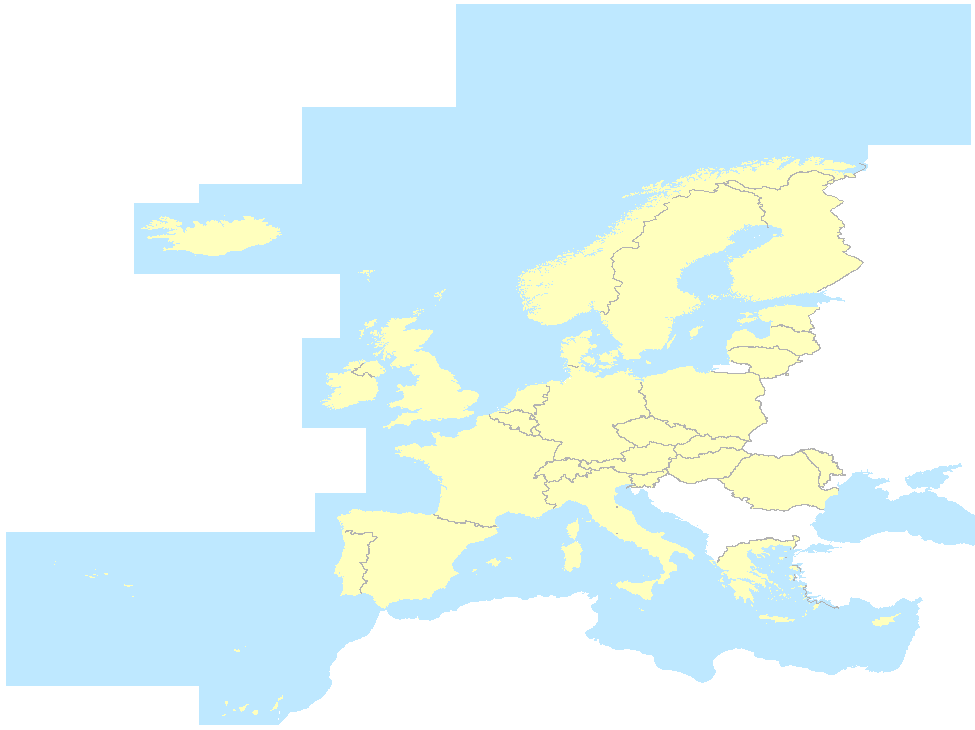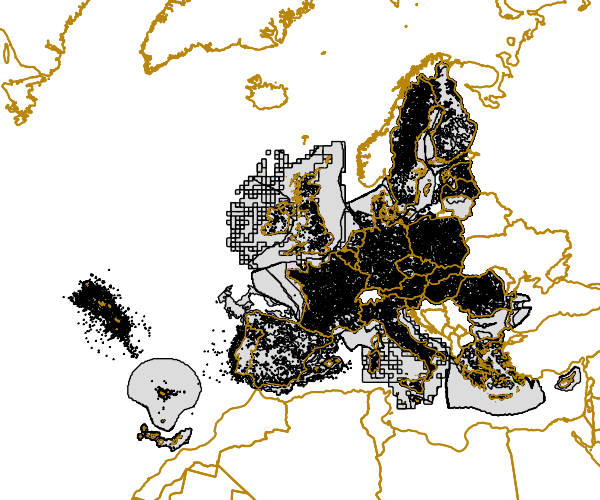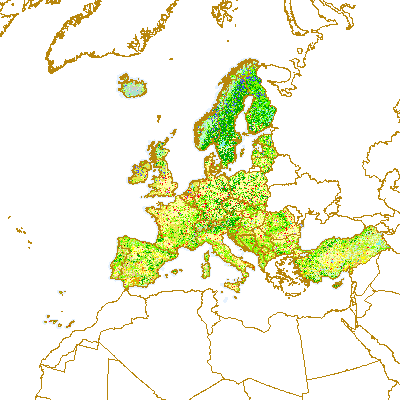FGeo
Type of resources
Available actions
Topics
INSPIRE themes
Keywords
Contact for the resource
Provided by
Years
Formats
Representation types
Update frequencies
status
Scale
Resolution
-

EuroRegionalMap v4.0 is a pan-European dataset containing topo-geographic information at the scale 1:250 000 assembled from 31 country data sets covering 26 EU Countries (Bulgaria not included), 4 EFTA countries, the Republic of Moldova. It is a seamless (there are no gaps between graphical objects initially derived from different sources) and harmonised data and is produced in cooperation by the National Mapping and Cadastral Agencies of Europe, using official national databases. Themes: a) Administrative (administrative boundaries, administrative areas) b) Hydrography (well, coastline / shoreline, foreshore, island, sea, aqueduct, lake / pond, reservoir, spring / water hole, waterfall, watercourse, dam / weir, lock, glacier, snow field / ice field, wetland) c) Transportation (railway, interchange of motorways, road, control tower, level crossing, ferry crossing, ferry station, entrance / exit, railway station, vehicle stopping area / rest area, pier / wharf / quay, airport / airfield, heliport, runway) d) Settlements (built-up area, named location) e) Soil and vegetation
-

Gridded Distribution of Species as reported during the Article 17 of the Habitats Directive (92/43/EEC) covering the period 2007 to 2012. The data covers the EU 27 (2007). All Member States are requested by the Habitats Directive (92/43/EEC) to monitor habitat types and species considered to be of Community interest. Article 17 of the Habitats Directive 92/43/EEC requires that every 6 years Member States prepare reports to be sent to the European Commission on the implementation of the Directive. The Article 17 report for the period 2007-2012 includes assessments on the conservation status of the habitat types and species of Community interest. This version does not include species flagged as sensitive by Member States. Information on the data quality of the 2007-2012 reporting round is available at http://bd.eionet.europa.eu/article17. The data are available in the table ART17_SD_without_sensitive of the database.
-

CLC06 is one of the datasets produced within the frame the Corine Land Cover programme referring to land cover / land use status of year 2006. The Corine Land Cover (CLC) is an European programme, coordinated by the European Environment Agency (EEA), providing consistent information on land cover and land cover changes across Europe. CLC products are based on the photointerpretation of satellite images by the national teams of the participating countries - the EEA member or cooperating countries. The resulting national land cover inventories are further integrated into a seamless land cover map of Europe. The resulting European database is based on standard methodology and nomenclature with following base parameters: - 44 classes in the hierarchical 3-level Corine nomenclature - minimum mapping unit (MMU) for status layers is 25 hectares - minimum width of linear elements is 100 metres - minimum mapping unit (MMU) for Land Cover Changes (LCC) for change layers is 5 hectares CLC programme provides important data sets supporting the implementation of key priority areas of the Environment Action Programmes of the European Community as protecting ecosystems, halting the loss of biological diversity, tracking the impacts of climate change, assessing developments in agriculture and implementing the EU Water Framework Directive etc.. CLC programme is also a part of the Global Monitoring for Environment and Security (GMES http://gmes.info) initiative, run by the European Commission and the European Space Agency, which will provide environmental information from a combination of air- and space-based observation systems and in-situ monitoring. More about the Corine Land Cover (CLC) programme and datasets can be found at http://www.eea.eu.
-

CLC00 is one of the datasets produced within the frame the Corine Land Cover programme referring to land cover / land use status of year 2000. The Corine Land Cover (CLC) is an European programme, coordinated by the European Environment Agency (EEA), providing consistent information on land cover and land cover changes across Europe. CLC products are based on the photointerpretation of satellite images by the national teams of the participating countries - the EEA member or cooperating countries. The resulting national land cover inventories are further integrated into a seamless land cover map of Europe. The resulting European database is based on standard methodology and nomenclature with following base parameters: - 44 classes in the hierarchical 3-level Corine nomenclature - minimum mapping unit (MMU) for status layers is 25 hectares - minimum width of linear elements is 100 metres - minimum mapping unit (MMU) for Land Cover Changes (LCC) for change layers is 5 hectares CLC programme provides important data sets supporting the implementation of key priority areas of the Environment Action Programmes of the European Community as protecting ecosystems, halting the loss of biological diversity, tracking the impacts of climate change, assessing developments in agriculture and implementing the EU Water Framework Directive etc.. CLC programme is also a part of the Global Monitoring for Environment and Security (GMES http://gmes.info) initiative, run by the European Commission and the European Space Agency, which will provide environmental information from a combination of air- and space-based observation systems and in-situ monitoring. More about the Corine Land Cover (CLC) programme and datasets can be found at http://www.eea.eu.
-

This data set contains the administrative boundaries at country level of the world and is based on the geometry from EBM v8.x. of EuroGeographics for the members of Eurogeographics, the Global Administrative Units Layer (2013) from FAO (UN) and geometry from the Turkish National Statistical Office. This dataset consists of 2 feature classes (regions, boundaries) per scale level and there are 6 different scale levels (100K, 1M, 3M, 10M, 20M and 60M). The public dataset is available at 1M, 3M, 10M, 20M, 60M, while the full dataset at 100K is restricted. This metadata only refers to the full dataset at 100k and shall only be used internally by the EEA. This metadata has been slightly adapted from the original metadata file provided by Eurostat (European Commission) and is to be used only for internal EEA purposes. For reference, the original metadata file provided by ESTAT (CNTR_2013.xml) is provided together with the dataset. The public dataset is available for download on http://ec.europa.eu/eurostat/web/gisco/geodata/reference-data/administrative-units-statistical-units/countries#countries13.
-

CLC90 is one of the datasets produced within the frame the Corine Land Cover programme referring to land cover / land use status of year 1990. The Corine Land Cover (CLC) is an European programme, coordinated by the European Environment Agency (EEA), providing consistent information on land cover and land cover changes across Europe. CLC products are based on the photointerpretation of satellite images by the national teams of the participating countries - the EEA member or cooperating countries. The resulting national land cover inventories are further integrated into a seamless land cover map of Europe. The resulting European database is based on standard methodology and nomenclature with following base parameters: - 44 classes in the hierarchical 3-level Corine nomenclature - minimum mapping unit (MMU) for status layers is 25 hectares - minimum width of linear elements is 100 metres - minimum mapping unit (MMU) for Land Cover Changes (LCC) for change layers is 5 hectares CLC programme provides important data sets supporting the implementation of key priority areas of the Environment Action Programmes of the European Community as protecting ecosystems, halting the loss of biological diversity, tracking the impacts of climate change, assessing developments in agriculture and implementing the EU Water Framework Directive etc.. CLC programme is also a part of the Global Monitoring for Environment and Security (GMES http://gmes.info) initiative, run by the European Commission and the European Space Agency, which will provide environmental information from a combination of air- and space-based observation systems and in-situ monitoring. More about the Corine Land Cover (CLC) programme and datasets can be found at http://www.eea.eu.
-

River Basin Districts (RBDs) and/or their subunits are the main units for the management of river basins and have been delineated by Member States under Article 3 of the Water Framework Directive. The geographic area of some RBDs span more than one country (such as the Danube) and these are known as International RBDs. Others are contained completely within a country and are known as National RBDs. River basin districts are defined as the area of land and sea, made up of one or more neighbouring river basins together with their associated groundwaters and coastal waters, which is identified under Article 3(1) as the main unit for management of river basins. Coastal waters are defined as one nautical mile from the coastline and extending, where appropriate, up to the outer limit of transitional waters. Coastal waters are included in RBDs, but this is not consistenly reported by Member States. Transitional waters are defined as bodies of surface water in the vicinity of river mouths which are partly saline in character as a result of their proximity to coastal waters but which are substantially influenced by freshwater flows. For more information about European waters, please visit the WISE portal (http://water.europa.eu/).
-

EU-Hydro is a dataset for all EEA39 countries providing photo-interpreted river network, consistent of surface interpretation of water bodies (lakes and wide rivers), and a drainage model (also called Drainage Network), derived from EU-DEM, with catchments and drainage lines and nodes. EU-Hydro Coastal Line is a separate layer extracted from EU-Hydro. The production of EU-Hydro public beta and the derived layers was coordinated by the European Environment Agency in the frame of the EU Copernicus programme.
-

EU-Hydro is a dataset for all EEA39 countries providing photo-interpreted river network, consistent of surface interpretation of water bodies (lakes and wide rivers), and a drainage model (also called Drainage Network), derived from EU-DEM, with catchments and drainage lines and nodes. The production of EU-Hydro public beta and the derived layers was coordinated by the European Environment Agency in the frame of the EU Copernicus programme.
-

TomTom's MultiNet Points of Interest (POIs) are businesses and landmarks important in vehicle and pedestrian navigation, internet mapping, and enterprise mapping solutions. MultiNet Points of Interest is an add-on product for Standard MultiNet. This metadata refers to the dataset with European and Russian coverage, in GDB format, published in September 2019. Data specifications and POIs categories and sub-categories are made available with the dataset. More information about TomTom here: https://www.tomtom.com/ IMPORTANT NOTE: This is a dataset provided by the European Commission's Eurostat to the EEA for internal purposes and its access is restricted. To request access to the dataset it is necessary to contact the SDI team, custodian for this dataset at EEA: sdi@eea.europa.eu.
 RUC Geo-Data catalogue
RUC Geo-Data catalogue